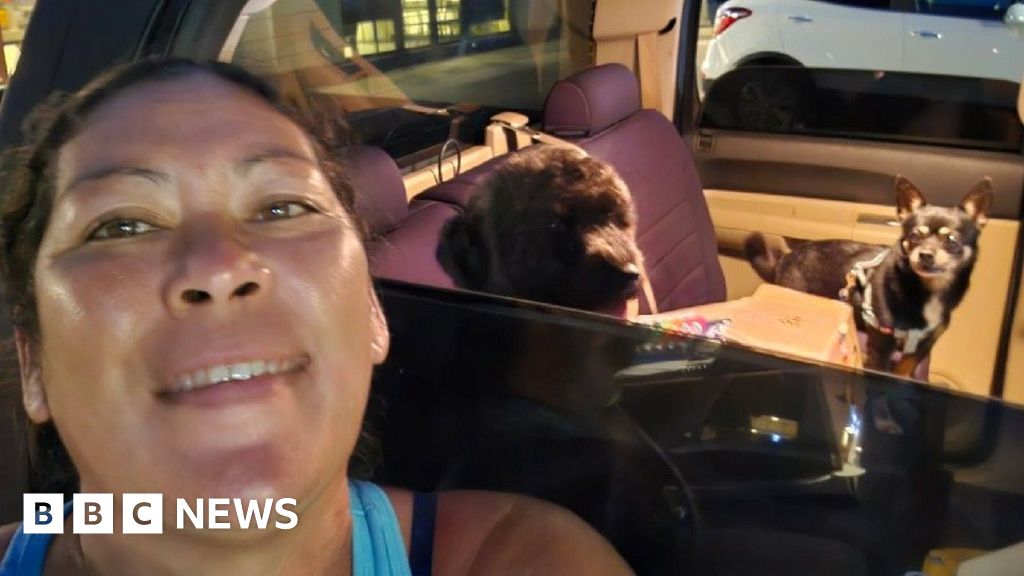BBC News, Washington state and Los Angeles
Many Hawaiians heeded official advice to leave coastal areas after a powerful earthquake thousands of miles away near Russia caused tsunami waves to reach the US state and other parts of the Pacific.
Waves several feet high were recorded on the islands of Maui, Oahu and Hawaii on Tuesday evening, the Pacific Tsunami Warning Center said, urging people to take “urgent action” to protect lives and property.
The centre later downgraded its tsunami warning for Hawaii to an advisory and Governor Josh Green struck a hopeful tone, saying he had yet to see a “wave of consequence” in the state.
Alerts were also downgraded early on Wednesday along North America’s Pacific coast.
Large coastal areas of Hawaii, California, Oregon and Washington are still under a tsunami advisory on Wednesday morning, however only a relatively short stretch of coastline in northern California is still facing a more severe warning, according to the National Tsunami Warning Center (NTWC).
An advisory for the Canadian province of British Columbia was cancelled on Wednesday morning.
A tsunami warning indicates that widespread flooding is expected or occurring, and those near the coast should evacuate to higher ground and inland. An advisory means there is the potential for strong currents or dangerous waves, with people urged to stay out of the water.
Although residents are able to return to their homes, officials warn the risk of powerful currents can continue for several hours or days after the initial waves, and have urged people to stay out of the water.
US seismologist Dr Lucy Jones earlier anticipated that the waves could damage harbours and waterfront properties in Hawaii – and possibly in California – but would not cause a catastrophic loss of life in the Americas.
The tallest waves were nearly six feet high in Hawaii.
Dr Jones noted that by comparison they reached 42ft (13m) during a deadly tsunami in Japan in 2011.
Many Hawaiians were taking no chances.
Residents on Maui, which was devastated by wildfires two years ago, were among those who moved to higher ground while the warning was in place.
David Dorn told the BBC that he was no stranger to tsunami warnings, having lived a block away from the ocean in the coastal city of Kihei, on Maui, for 30 years. But he and his wife were treating this one differently.
“We try and take them all seriously, but most people kind of take them a bit lightly,” he said of the warning sirens that had been blaring since the first alert was issued.
He and his wife had evacuated to higher ground and were planning to spend the night in their van at an inland shopping centre.
Mr Dorn said that before leaving their home, he had moved his electronics up to their loft, hoping that even if seawater penetrates the building it would not reach the rafters.
His biggest concern was the roads, especially if electrical poles fell and blocked them.
“Traffic’s always a problem, and its getting worse. And it’s at its worst in any emergency like this,” he said.
Another Maui resident, Roger Pleasanton, told the BBC that the traffic was “like New York City right now”.
“I was going to go to the grocery store, but I think I may have to skip the groceries and get out of here,” he added.
 Felicia Johnson
Felicia JohnsonAs Maui prepared for the arrival of the waves, shelters were opened and water facilities were shut off to protect them from possible damage.
It had been 10 years since Felicia Johnson, a lifelong resident of the island, last fled from a tsunami. Late on Tuesday, she again found herself moving to higher ground.
Ms Johnson, 47, had watched the water level recede and then rise significantly – describing a pattern typically seen with tsunamis.
“It’s eerily weird,” she exclaimed, while packing her truck to spend a night with her family and friends in the mountains.
She compared the situation to the fire that hit the town of Lahaina two years ago, devastating the island and its community.
“All I can do is leave the house. I’m leaving, so I’m definitely worried something’s coming. But I mean, what can you cry about?
“We went through this with the fires, and there was no warning, and it was just so devastating. Now, we have so much warning that if we don’t go it’s our fault.”
Waves reaching 5.7ft (1.74m) have been recorded at Kahului, Maui, and one of 4.9ft was recorded in Hilo, Hawaii.
In California, the first waves were relatively small. A 3.6ft wave was recorded in Crescent City, in the far north of the state, with smaller waves of 1.6ft hitting Arena Cove, north of San Francisco, and further down the coast.
The National Weather Service (NWS) warned of potentially higher crests in one section of the Pacific coast near Port San Luis, roughly halfway between San Francisco and Los Angeles.
The NWS Los Angeles office posted: “Do not return to inundated areas as waters will recede, but could return multiple times through the next 24 hours, and the first wave may not be the largest.”
At one point the agency’s San Francisco office said it was recording tidal swings of up to 2.5ft in as little as 15 minutes and advised: “It’s just a good idea to stay away from the water today!”
At Manhattan Beach in Los Angeles County, however, some were relaxed about the threat.
George Mejia, 25, and his two cousins were packing up their longboards in their convertible when his mom called.
“She said, ‘Did you see there was a huge earthquake and there’s maybe gonna be a tsunami?’ I was like, ‘No, I’ve been in the water!'”
Instead of speeding off, the trio sat in their car and peered out at the ocean, talking about heading back in and riding tsunami waves.
Blue tsunami evacuation route signs line many roads along the US west coast.
In Canada, wave heights have so far remained below 1ft.
And a tsunami advisory on the island of Guam, a US territory about 2,500km south of Tokyo, was cancelled. Island officials said there was no further threat of waves, but warned of stronger currents over the next day.
The earthquake that triggered the tsunami is one of the most powerful of modern times. Since modern seismography began in 1900, only five earthquakes have been stronger.
With additional reporting by Christal Hayes

